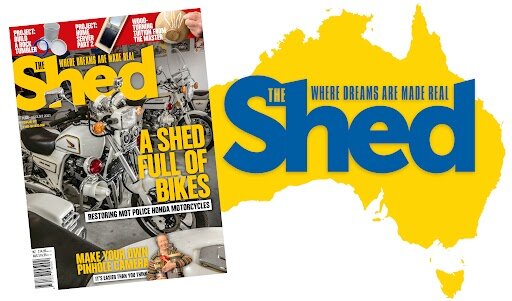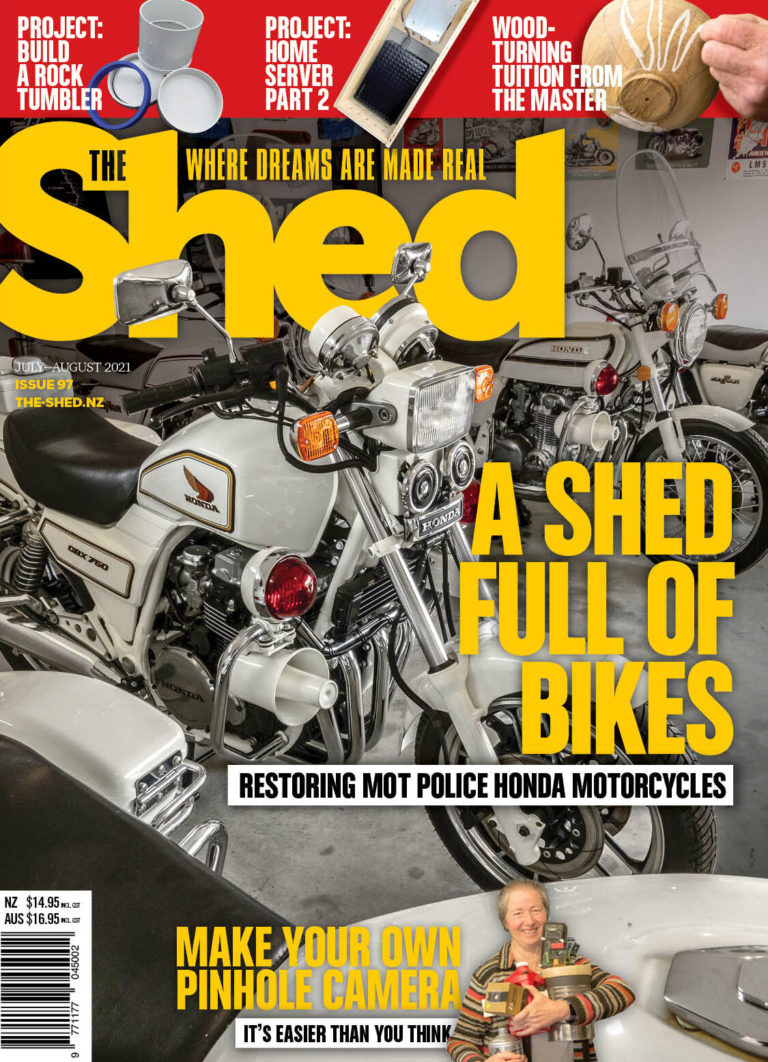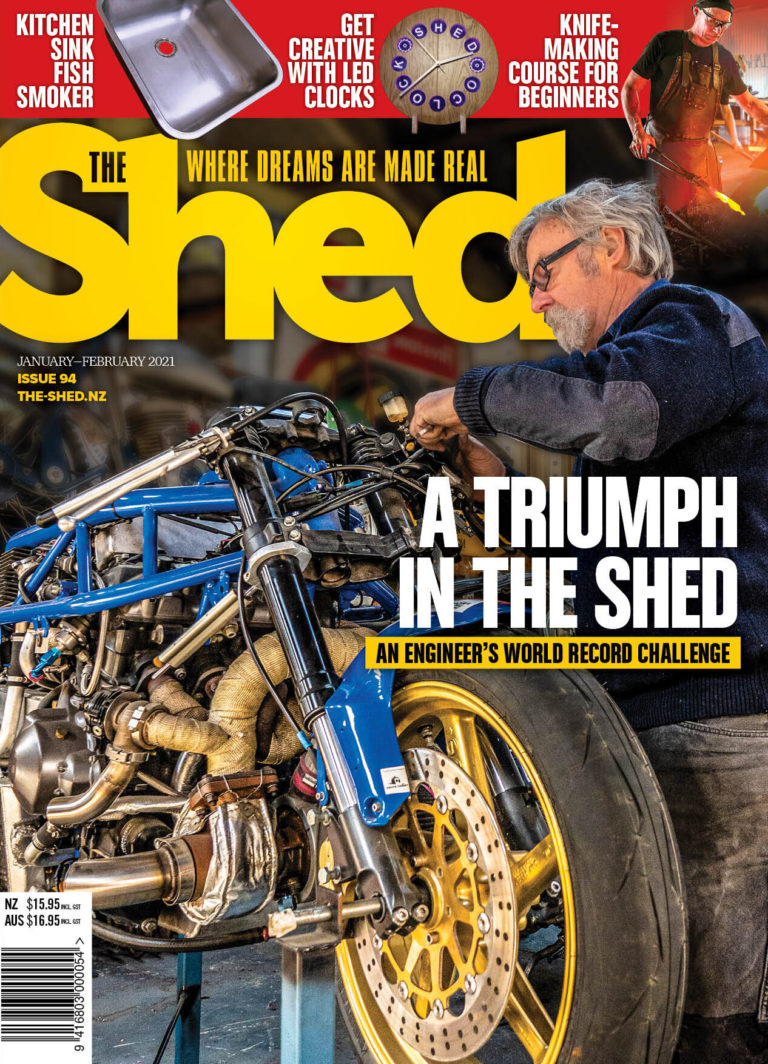Completing the second part – the engine
By Robin Overall
PHOTOGRAPHS: ROBIN OVERALL, JUDE WOODSIDE DIAGRAMS: ROBIN OVERALL
The steam engine complete
In Part One, we focused on the boiler for a small steam engine. Now we come to the interesting part—the engine.
Although daunting at first, it is fairly logical if tackled a small step at a time. The use of a lathe is desirable but with a little lateral thinking it would be possible to make it without one.
First the cylinder is made from a short length of 12 mm round brass rod. Mount this in the three-jaw chuck of your lathe and face off one end. When turning brass it is necessary to grind the tool with a negative rake (see diagram). Brass is extremely brittle and the point of a tool bit with a positive rake would bite and snap off, being thinner and weaker. Brass must also be turned at much faster speeds than steel and without lubrication of any sort. Don’t forget to wear safety glasses or better still a full-face mask, as the bits fly everywhere at times. With a centre drill (slocombe) in the tailstock chuck, start a hole in the turned face. Then using a 6 mm bit, drill to the required length. Increase to a 9 mm drill and re-drill. This will be the in-side diameter of the cylinder. Finally use a reamer and ream the cylinder smooth. The purchase of a small expandable hand reamer is money well spent as increasing the bore size slightly is much simpler than turning the piston down to get a perfect fit. The brass needs to be held in the chuck with minimum pressure so as not to mark it too much. I also use a small piece cut from a drink can as a shim to avoid marks.
A piece of brass this size requires a speed of approx 700 rpm. If you do not have access to a lathe then you will need to use brass tube and solder an end-cap in place. The tubing will still have to be reamed. Finding brass tubing that has an inside diameter matching the brass rod suitable for a piston could be a bit of a mission.
Creating the crank wheel.
Saddle
Next make the saddle. The saddle acts as a transition from the curved surface of the cylinder to the flat surface of the pivot plate/stand. This is cut from 8 mm stock. The size is not critical as long as it has enough meat to accommodate the cylinder. This operation can be done by hand with a suitable file or on the milling machine. If milling, remember that “fast and dry” is the order of the day. The sides of the saddle are chamfered for looks rather than any constructional reason. It sim-ply adds a little flair.
The cylinder and saddle are soldered together as one piece and this needs a little attention to detail to get it right. The saddle needs to be grooved to accommodate the cylinder. Scribe a line down the centre of the saddle and start the groove with a square file. Progress to a round file and then finally wrap a length of emery cloth around the cylinder and lap the cylinder into the groove. This needs to be as close a fit as possible in order that no unsightly seams of solder are visible when it is finally assembled.
Drill a pivot hole through the centre of the saddle and tap it to accept an M3 machine screw. Rub the end of the screw thread with a soft pencil (graphite) and screw it into the tapped hole until it is flush with the base of the groove. With a gentle pencil flame on an LPG burner, tin the surface of the groove and a portion of the edge of the cylinder with soft solder. Wipe off any excess. Position the tinned surfaces together and gently bind with soft wire to hold in place. Apply heat to the assembly and allow to settle together. Leave to cool. After it has cooled, if the alignment is not right you will have to reheat and start again, but it should be OK if you take care the first time. The screw should be easily removed if it was coated with graphite correctly. The assembly can now be cleaned up with wet-and-dry and Brasso.
The mating surface of the saddle/cylinder assembly needs a relief area to be milled out of it to reduce friction between the saddle and pivot face of the engine stand. This can be filed if you prefer but milling is easier. Once this has been done, the mating surfaces need to be made as flat as possible. This is best done by rubbing gently on a file followed by wet-and-dry working down the grades from 200 grit through to 1000 grit. Finally lap them together with Brasso.
Piston
The piston is fiddly, rather than difficult to make. Put a short length of 10 mm brass rod in the chuck and face off. Using a slocombe drill in the tail stock, mark the centre and then drill with a 3 mm drill to a depth of approximately 5 mm. Adjust the rod in the chuck so enough material is protruding to enable a 15 mm piston to be turned and eventually parted off.
Turn this section down to fit snugly into your cylinder. I use a Vernier as a gauge and then finally take light cuts, testing regularly by slip-ping the cylinder over the piston to get a “popping” fit. This may not be very technical but it gets the mes-sage across to my students.
The cylinder is slid over the piston. When it is removed, a slight pop-ping sound is heard. At this stage it can be parted off and then silver-soldered onto the con rod, which is a short length of 3 mm brazing rod. Be generous, as the final length will be determined later.
The next move is to lap the two together with Brasso until you are satisfied with the fit. Not too tight and not too loose. The next stage is to fit the big end but this can be left for the moment until the crank wheel and flywheel are made. If no lathe is available, then a close size of brass rod can be resized by chucking it in a drill and filing and sanding it to size.
Preparing the saddle
Centre drill out the cylinder.
Flywheel
The flywheel is constructed from brass but could be made from mild steel if preferred. Size, like many things in life, doesn’t actually matter as much as one would think. What is more important is weight. I have used 30 mm diameter brass rod for the flywheel and 25 mm for the crank wheel. The machining process is much the same as the piston with the addition of a recess turned into the face of one side for aesthetic reasons only. The finished thickness of the flywheel is 15 mm. Drill the centre to accommodate a 6 mm stainless steel shaft.
A neat idea I came across for this is to drill part way through the fly-wheel with a 5 mm drill and then re-drill part way through with the 6 mm drill from the back. Then ta-per the end of the shaft a little so the flywheel fits tightly onto it. When the final facing takes place, the shaft end is faced off neatly. When placing the flywheel in the chuck, it is important to get it accurately positioned each time. Use a packing piece of wood that bridges the hole in the chuck and ensures the flywheel sits parallel to the chuck face (see diagram).
The engine front…
…back…
..and sides.
The spring over the screw provides tension to keep the mating surfaces in contact.
Crank wheel
Face off a length of 25 mm brass and then start a hole with the slocombe drill and finish with a 6 mm drill. Part off so you finish up with an 8 mm-thick wheel. It is attached to the 6 mm shaft with a grub screw. The next stage is to drill for the crank pin and this is done in the drill press. The distance of the crank pin from the centre of the wheel is half the stroke of the piston.
Assembly
Now is the time to fit the big end to the con rod and crank wheel. This is normally done by reference to any drawings you have and marked out very carefully. This can be a tad daunting to the beginner not used to the detail that engineering constraints require.
I have adopted a simpler approach. This involves assembling the fly-wheel and crank wheel, then positioning the cylinder and piston in place with the big end engaged with the crank wheel pin. This is done on the bench as the final lay-out determines the size of the engine stand.
The length of the con rod is determined at this stage. Move the piston in the cylinder until it is in as far as it will go, leaving a small gap of approximately 6 mm at the top. This is known as top dead centre (TDC). Then using a 1.5 mm drill, drill through the cylinder AND the saddle. The hole in the outer surface of the cylinder will be soldered over later.
Stand
This is probably the most difficult part to get right and yet on the surface it is the easiest to construct. The cylinder/saddle assembly pivots against the pivot plate. In some engines this is small piece of brass, which in turn is mounted on a stand or frame. I have designed mine to be an integral part of the stand. I have constructed the stand also out of brass as this is reason-ably easy to work with. The stock is 25 mm x 10 mm. The length is determined by the final size of your cylinder/flywheel assembly above. Mark the position of the flywheel shaft then drill that. A free-running fit is required. Assemble the engine in position with the saddle flush with the stand. Then drill the stand to accommodate the M3 screw that attaches the saddle.
The saddle is attached to the stand with a spring over the screw to provide tension which keeps the two mating surfaces in contact. A small blob of solder is put over the hole in the outer wall of the cylinder and this is filed smooth.
Drilling cylinder and saddle.
Saddle, cylinder and piston.
Drilling steam ports
The cylinder has a 1.5 mm hole drilled in it to allow steam to both enter and exit from it. This hole alternates between the inlet port and the outlet port by way of the whole cylinder oscillating with the machine screw as an axis. (see diagram)
Use a 1.5 mm drill to mark out the port positions on the stand. Disassemble the engine and then drill the marked positions to half the thickness of the stand with a 2 mm drill. Then drill down from the top of the stand to coincide with these ports. The holes drilled from the top are then re-drilled part-way with a 3 mm drill to accommodate the 3 mm copper tubing from the boiler and to the exhaust.
The annealed exhaust tube is soft-soldered into one of these enlarged holes and then bent to shape. The connection to the boiler is made by cutting a union nut in half and soldering it to the stand. Copper tubing is annealed by heating to red heat and quenching in water. If shaped quickly, it will then retain that shape. If overworked, it will re-harden and will require annealing again. The olives and nuts are fitted and they are then ready for connection.
Drill crank wheel for grub screw.
Flywheel (left) and crank wheel.
Assembly, testing
It is helpful if the boiler assembly and engine are mounted on a wooden base. This not only looks good but it keeps everything stable and avoids connections vibrating loose. The copper pipe is connected to the boiler and the engine stand with union nuts. Ensure these are done up tightly. Fill the boiler until the water dribbles out of the filler hole and then screw it up tight. These fit-tings all benefit from having O-rings on them.
Fill the burner tray with methylated spirit, light this and place the tray in the boiler housing. The water will take a couple of minutes to reach boiling point and then steam should begin to force its way out of any loose joints. Tweak these up and flick the flywheel over until it begins to run under its own steam (so to speak).
Fine adjustment can take a while and is dependent on numerous factors such as the tightness of the saddle/stand connection and the tightness of the piston. It is some-times helpful to lubricate the piston assembly with a light machine oil from time to time.
This model is a really simple version and an ideal one for a beginner. Once you have mastered this you should be able to go on and make many more models of varying complexity. Happy steaming!
Brass stand with steam inlet and outlet.
Finding the vertical.



